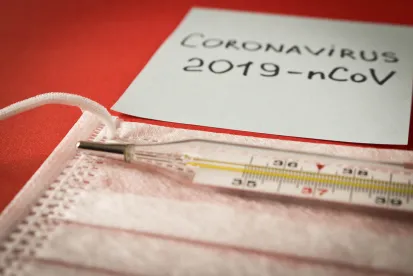Over the past several months, the federal Occupational Safety and Health Administration (OSHA) has steadily issued guidance to both employers and agency officials on strategies to navigate regulatory matters related to the COVID-19 pandemic, as we have discussed here, here, here, here, and here. However, federal OSHA is not the only government agency addressing the crisis at hand. Below is an outline of efforts OSHA State Plan agencies have also implemented, as of April 23, 2020, to address COVID-19 issues in the workplace. Should you operate in any one or more of these jurisdictions, you will want to be cognizant of the guidance outlined below. (Please note that this outline is limited to measures that state “OSHA” agencies have taken to address COVID-19; it does not include all state measures that state governments have taken, such as shelter-in-place orders, business closures, public health orders, and so forth).
No additional COVID-19 measures or guidance beyond federal OSHA
-
Alaska: Alaska Occupational Safety and Health (AKOSH)
-
Arizona: Arizona Division of Occupational Safety and Health (ADOSH)
- Illinois*[1]: Illinois OSHA
- Indiana: Indiana Occupational Safety and Health Administration (IOSHA)
- Iowa: Iowa OSHA
- Kentucky: Kentucky Department of Workplace Standards
- New York*: The Public Employee Safety and Health Bureau (PESH)
- Tennessee: Tennessee Occupational Safety and Health Administration (TOSHA)
- Utah: Utah Labor Commission Occupational Safety and Health Division (UOSH)
- Virgin Islands*: Virgin Islands Division of Occupational Safety and Health (VIDOSH)
Additional COVID-19 measures or guidance beyond federal OSHA
California: California Division of Occupational Safety and Health (Cal/OSHA)
- Aerosol Transmissible Diseases (ATD) standard aimed at preventing worker illness from infectious diseases that can be transmitted by inhaling air that contains viruses (including COVID-19), bacteria or other disease-causing organisms. The ATD standard is only mandatory for certain healthcare employers in California, namely workplaces at high risk for infectious diseases such as hospitals, clinics, emergency medical services, laboratories, prisons, and homeless shelters. However, it also can provide useful guidance for protecting other workers exposed to COVID-19 in similar settings.
- Cal/OSHA Interim Guidelines for General Industry on 2019 Novel Coronavirus Disease (COVID-19) is divided into industries subject to the ATD standard, those not subject to the ATD standard, and workplaces where there is significant risk of exposure.
- Cal/OSHA Guidance on Requirements to Protect Workers from Coronavirus helps guide employers on compliance with the ATD standard set forth above, addresses related issues such as respirator shortages and industry-specific health and safety guidance, and provides education materials and fact sheets relevant to COVID-19.
Connecticut*: Connecticut Division of Occupational Safety and Health (CONN-OSHA)
- A website dedicated to N95 respirator resources, including use and fit testing, a sample written respiratory protection program, a worksheet for developing a written respirator program and links and information on federal OSHA’s respirator protection standard.
Hawaii: Hawaii Occupational Safety and Health (HIOSH)
- An Occupational Risk Pyramid for COVID-19 helps employers classify worker exposure to SARS-CoV-2 as either very high, high, medium or low exposure risk.
- A COVID-19: Workplace Guidelines FAQ lists seven (7) frequently asked questions and answers specific to employers and COVID-19.
- On March 16, 2020, HIOSH announced it will follow the federal OSHA enforcement memorandum related to Temporary Enforcement Guidance for Healthcare Respiratory Protection Annual Fit-Testing for N95 Filtering Facepieces During the COVID-19 Outbreak.
Maine*: Maine Department of Labor (MDOL)
- Effective March 23, 2020, MDOL announced it will temporarily adopt the federal OSHA enforcement guidance for N95 respirators for state and local government healthcare employers, which recommends that healthcare employers change from a quantitative fit testing method to a qualitative testing method to preserve the integrity of N95 respirators.
Maryland: Maryland Occupational Safety and Health (MOSH)
- COVID-19 Facemasks vs. Respirators: Understanding the Difference analyzes the differences between cloth or paper face masks, surgical face masks and filtering facepiece respirators (such as an N95 mask). The Fact Sheet also provides an “Employer Guide to Voluntary vs. Required Respirator.”
Michigan: Michigan Occupational Safety and Health Administration (MIOSHA)
- MIOSHA relies on the Michigan Attorney General’s guidance for determining whether a worker is a “critical infrastructure worker.”
- MIOSHA and the Michigan Governor issued guidance for business that addresses whether workers may leave home for work.
- MIOSHA and the Michigan Governor issued guidance for individuals that addresses whether individuals may and may not leave their home.
Minnesota: Minnesota Department of Labor and Industry and Minnesota OSHA (MNOSHA)
- A frequently asked questions document specific to employers and employees addresses such topics as whether critical sector employees need a special certificate or permit, whether employers can require employees to work from home, whether employers can change their employees’ regular work schedules, whether employers are required to make employees with underlying health conditions work from home, and many more.
- Worker protections related to COVID-19, including use of sick leave, the federal Family Medical Leave Act, the federal Families First Coronavirus Response Act, rights to non-discrimination under the Minnesota Human Rights Act, unemployment insurance benefits, protections for workers who contract or have been exposed to COVID-19, workers’ compensation, final wages, changes to working conditions, hours worked and hours paid and workplace safety and health.
- COVID-19: Protecting grocery store workers, including plans for effective handwashing and social distancing, ensuring sick workers are not at work, prohibiting workplace discrimination, educating workers about how to prevent coronavirus transmission, checkout stand and counter considerations, stocking shelves and cleaning surfaces as well as other protective measures.
- Safety and health guidelines for the employers and employees of essential work operations that covers fundamental safety and health control measures that should be employed to minimize exposure to COVID-19 from transmission through basic activities and functions, such as coughing, sneezing and talking.
Nevada: Nevada OSHA (NVOSHA)
- COVID-19 Guidance for Mining, Construction & Manufacturing provides specific guidelines for the management of staff and labor in the mining, construction and manufacturing industry sectors.
- COVID-19 Memorandum for Essential Businesses provides recommendations and measures that apply to all essential businesses that remain open during the pandemic.
- Notice on Declaration of Emergency Directive 009 (Revised) Related to Legal Proceedings, Permits and Licenses: Occupational Safety & Health Administration extends certain photo-voltaic and asbestos licenses for 90 days, and generally extends the citation and review process by 30 days.
- COVID-19 Letter for Construction Industry highlights that construction sites in Nevada were not complying with state directives related to COVID-19 mitigation, reiterates previously stated guidelines for the construction industry and warns of periodic and random inspections as well as penalties for ongoing non-compliance.
New Jersey*: Public Employees Occupational Safety and Health Office (PEOSH)
- OSHA’s Rule Relaxation for Fit Testing and Use of Expired Respirators offers a variety of frequently asked questions and answers related to expired N95 masks and serves as guidance for EMS responders in the state.
New Mexico: New Mexico Environment Department Occupational Health and Safety Bureau (NM OSHA)
- Recommendations for employers regarding COVID-19 provide a variety of recommended precautions for employers in the state to follow.
- New Mexico Occupational Health and Safety Bureau COVID-19 Frequently Asked Questions (FAQ) provide answers to some of the frequently asked questions that have been received by NM OSHA about COVID-19.
North Carolina: North Carolina Department of Labor Occupational Safety and Health Division (OSHNC)
- FAQ’s Regarding COVID-19 address a variety of North Carolina employer- and employee-specific questions and answers regarding COVID-19.
- A website dedicated to COVID-19 “Solutions” includes information on specific engineering, administrative and work practice controls and personal protective equipment, as well as resources to assist employers in the state, including a variety of presentations and webinars specific to COVID-19 exposure.
- A host of Guidance, Fact Sheets and Hazard Alerts, including on respiratory protection.
Oregon: Oregon Occupational Safety and Health (Oregon OSHA)
- Interim Guidance Related to COVID-19 reiterates that it is still employers’ responsibility to ensure that their employees are adequately protected. The interim guidance addresses new and modified rules with respect to certifications, monitoring and training, agriculture labor housing and safety committees and meetings.
- Scope of Oregon OSHA COVID-19 Activity offers a variety of questions and answers regarding Oregon OSHA’s education and enforcement of issues related to COVID-19.
- COVID-19: Job Health, Safety Resources for Oregon Contractors encourages construction contractors that continue to operate to work closely with their safety specialists and legal counsel to ensure that they are in compliance with the requirements set out in this guidance. The guidance addresses requirements for construction worksite safety, worker responsibilities, social distancing, personal protective equipment, sanitation and cleanliness, workers entering occupied buildings or homes, job site visitors and general job site/office practices.
Puerto Rico: Puerto Rico OSHA (PR OSHA)
- Recommendations to Employers (Spanish)
- Risk Alert for Employers (Spanish)
- COVID-19 Rules (Spanish)
- Compliance Guide for Respiratory Protection and Shortage of N95 Filtering by the 2019 Coronavirus Pandemic (COVID-19) (Spanish)
- Basic Elements of an Exposure Control Plan to COVID-19 for Employers (Spanish)
South Carolina: South Carolina Occupational Safety and Health Administration (SCOSHA)
- COVID-19 in Dental Settings addresses dental health care personnel, emergency dental procedures, PPE in the dental setting and additional controls in the dental workplace.
- Interim Guidance – N95 Respirator Use in Patient Care advises that employers continue to use N95 respirators or comparable respirators for full protection of workers in prescribed situations.
Vermont: Vermont Safety and Health Administration (VOSHA)
- COVID-19 Frequently Asked Questions includes questions and answers specific to employers and employees, respectively.
Virginia: Virginia Occupational Safety and Health (VOSH)
- Consultation Newsletter, the first edition of which covers what is COVID-19, provides an outlook for a new economy, adhering to guidelines to slow the spread of the coronavirus, COVID-19 facts and symptoms and testing.
- Coronavirus (COVID-19) VOSH Hazard Alert covers workplace safety, prevention, screening, guidance for an epidemic policy/program, and implementing workplace controls and PPE.
Washington: Washington State Department of Labor & Industries Division of Occupational Safety and Health (DOSH)
- Detailed guidance for business and workers, including industry-specific and task-specific guidance (issued along with the Washington State Department of Health).
Wyoming: Wyoming OSHA
- Protecting Grocery & Other Essential Workers from COVID-19 sets forth COVID-19 prevention guidelines and recommendations specific to grocery and retail workplaces.
- A website dedicated to “Important Information and Resources for Employers.”
- A website dedicated to “Important Information and Resources for Individuals.”
[1] States with an asterisk (*) have OSHA-approved State Plans that cover only state/local government workers. States without an asterisk have OSHA-approved State Plans that cover private and state/local government workplaces.





 />i
/>i

